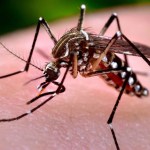Brazil
Last week, I wrote about how conspiracy theories have been flowing fast and furious about the Zika virus and microcephaly. Even if you didn't see that post (perhaps instead having seen this one), you've probably seen the news reports describing how last fall the observation of a large number of cases of microcephaly, characterized by an abnormally small head and delayed brain development, in Brazil led researchers investigating the problem to suspect a link to a virus. That virus, the Zika virus, as you recall, is a mosquito-borne flavivirus related to dengue virus and transmitted primarily…
On The Pump Handle, Liz Borkowski reports on a "public health nightmare" in Brazil that threatens to become more common around the world. The culprit is a virus called Zika, known to cause mild infections since 1947 but now "linked to nearly 4,000 cases of microcephaly – infants born with abnormally small brains and heads." On Aetiology, Tara C. Smith writes that the link between Zika and microcephaly is not conclusive, and explains how scientists will search for a definite relationship. In the meantime, officials in Brazil and other South American countries are telling women to postpone…
Check out the tiny new species of frogs discovered in the cloud forests of Brazil.
Brachycephalus mariaeterezae
Brachycephalus fuscolineatus
Brachycephalus verrucosus
Brachycephalus leopardus
Brachycephalus boticario
Brachycephalus olivaceus
Images from LiveScience.
Two giant anteaters fight it out. On the left, the individuals lash out at each other with their enormous claws, and on the right they posture at each other (with the dominant animal, with the upright and puffed-out tail, on the right). From Kruetz et al 2009.
In the northern state of Roraima in Brazil, small plantations of the black wattle tree (Acacia mangium) serve up plenty of food to carpenter ants and other insects, and the variety of six-legged pests has attracted numerous giant anteaters. The trouble is that these immense xenarthrans don't typically get along very well.
As…
One of the problems with human genetics where it resembles economics are the ethical issues involved in experimentation. Luckily for science, but unluckily for individuals, medicine offers many "natural experiments." But in the area of population genetics and history analyses of pedigrees or family based studies centered around particular traits and genes have limitations of scale. Luckily for science again, and unluckily for millions of Amerindians and black Africans, Latin America offers a cornucopia of possibilities when it comes to exploring the outcomes ensuing from admixture between…
Stories in Spanish: Costa Rica becomes the first Central American country to confirm swine flu ("gripe porcina"). A 21 year old who had traveled to Mexico is in stable condition. An additional 16 cases were examined but were negative. Brazil is also examining 11 travelers; cases are also being examined in Panama, Honduras, Argentina, and Uruguay, and Chile.
In Asia, South Korea is examining a possible case, while China's stepped up its efforts to look for cases (and blocked import of pork from the US and Mexico).
Most of the cases that are being examined have traveled to Mexico…
ScienceBlogs Brazil brings together the most original and influential voices within the Brazilian science community, some of whom have already won accolades for their blogging. Edited from São Paulo by Carlos Hotta and Atila Iamarino, ScienceBlogs Brazil launched Tuesday with 23 Portuguese-language blogs on topics ranging from genetics to the environment. "I think we need people committed to raising scientific awareness in Brazil," said Carlos Hotta, "and I am certain that ScienceBlogs Brazil will turn our local voices into global ones."
-->From Sb Brazil Community Managers Carlos Hotta…
Lachnomyrmex amazonicus - Feitosa and Brandão 2008
The new world tropics continue to be a rich source of species discovery. Today's issue of Zootaxa contains a monograph by Rodrigo Feitosa and Beto Brandão revising the ant genus Lachnomyrmex, a small yet delightfully wrinkled group of soil-dwelling ants. Of the 16 species recognized in the new paper, ten were previously unknown. For the mathematically-challenged, that's more than half.
Lachnomyrmex amazonicus, pictured above, is one of the new species. It has been recorded from lowland humid forests in the…
tags: researchblogging.org, birds, SincoraÌ Antwren, Formicivora grantsaui, ornithology, Brazil
Male SincoraÌ Antwren,
Formicivora grantsaui.
Potentially a new bird species that was recently discovered in Brazil.
Image: Sidnei Sampaio. [larger view].
In a world where many humans believe they know the identities of every living thing on the planet, it is truly refreshing to learn that we have found yet another species of bird that is new to science. This new species was recently found in eastern Brazil. The bird was captured, studied and its vocalizations were recorded by ornithologists.…

